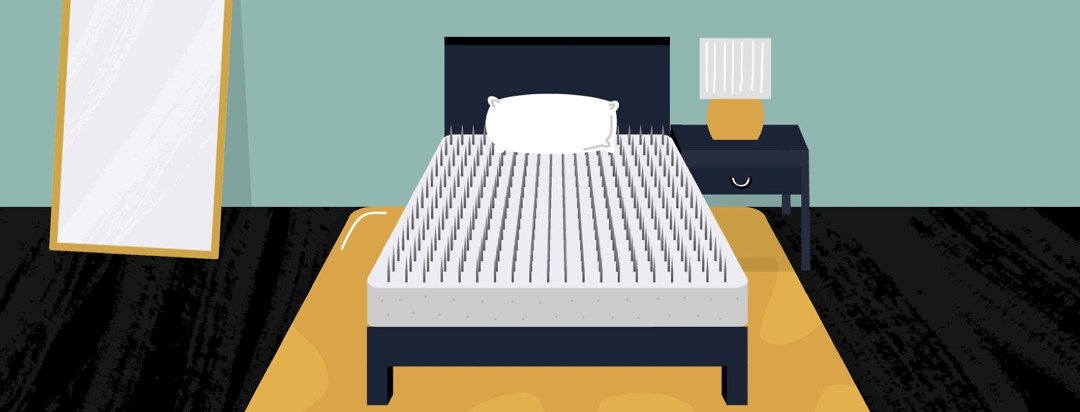Can a Modern-Day Bed of Nails Relieve RLS?
When you live with a chronic condition like restless legs syndrome (RLS), it stands to reason that you’ll seek out relief wherever you find it. Often, treatment is as simple as an iron or magnesium supplement. But for many, especially at bedtime, solutions to this prickly movement disorder of sleep come up short.
Emerging as one solution is the acupressure mat, which may bring relief for nightly bouts of RLS discomfort.
What is acupressure?
This alternative therapy claims roots in Eastern medicine. You may also know it as shiatsu, which means “finger pressure” in Japanese.1
Acupressure involves applying pressure to points along areas of the body known as meridians.
Meridians
Meridians are thought to be connected channels—14 in all—that deliver energy (“chi” or “qi”) throughout the body. It’s thought that when chi becomes blocked, it creates pain, fatigue, and the right conditions for disease.2
So it goes that, when applying pressure to the meridians, chi may become unblocked and flow freely again. The pressure applied in this therapy may increase levels of dopamine—the “feel good” hormone—in the body, inciting a relaxation response.3
Lymphatic system
Acupressure is also thought to improve the function of the lymphatic system.4 This component of both the circulatory and immune systems is composed of tissues, vessels, organs, and ducts bathed in a fluid known as lymph. Lymph exists to transport white blood cells throughout the body.5
Gate-control theory
The effectiveness of acupressure could be scientifically explained by something known as gate-control theory, in which multiple sensations applied over a specific area produce reductions in pain by scrambling pain signals.6 This could also describe the pain-relief strategy offered by TENS (transcutaneous electric nerve stimulation).7
What happens during an acupressure session?
In an acupressure session, the trained practitioner delivers pressure to your meridians using their thumbs, palms, and, sometimes, their elbows. Its effects may be compared to deep tissue massage.
Can’t get to an acupressure therapist? No worries, you can also use an acupressure mat.
How does an acupressure mat work?
Also known as a shiatsu mat, an acupressure mat is a slim cushioned mat covered in strategically placed plastic discs decorated with many small upright spikes.
If you’ve ever heard of a “bed of nails,” then this evokes that same image. Naturally, the spikes are plastic and not meant to pierce your flesh like nails might!
It’s worth mentioning that gurus and yogis from ancient times often used beds of nails for healing and meditation. That’s the inspiration behind today’s acupressure mats.
Some acupressure mats are meant to treat the whole body and come with attached pillows. Other miniature versions can be applied to specific parts of the body.
Targeting the meridians
Like an acupressure session, the mat, when used appropriately, is designed to target the meridians, applying sharp pressure which may, in turn, improve blood flow and the release of chi. Make sure you use your mat in a warm, dimly lit space conducive to relaxation, with no electronic distractions nearby.
Laying on the mat
You should follow the manufacturer’s directions for best results but generally speaking, you lay the mat on your bed and place a sheet over the top of it. Then, ideally, you completely disrobe, then simply and slowly lie down on it. Feel free to cover yourself to keep warm. Your head should rest on a separate pillow with the spikes ending at the base of your skull.
Reclining on an acupressure mat may be easier said than done, as some discomfort from the general “pokiness” of the spikes may occur.
If you can tolerate the sensation—many do, even if some don’t—the discomfort eventually fades. Try waiting 10 minutes for it to pass. Then remain on the mat for as long as necessary to find relief.
Once you arise after using the mat, you will find tiny red “tattoos” pressed into the skin where pressure was applied. These will go away in a few minutes.
Can an acupressure mat bring relief for RLS?
Some people employ it by placing a miniature version under their calves at night while in bed, allowing it to help them relax the leg muscles so they can fall asleep.
Does it work? Maybe. Scientific research still hasn’t provided sufficient evidence to support this approach, but people experiencing severe problems with RLS anecdotally support its therapeutic use and find it helps them sleep. Fortunately, most acupressure mats on the market are affordable and easy to maintain, making them a worthwhile option if other therapies haven’t worked for you.
Interested in reading more about lifestyle changes for symptom relief? Explore our featured collection on lifestyle changes and alternative treatments for RLS.

Join the conversation